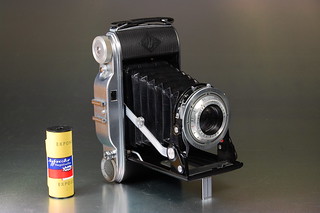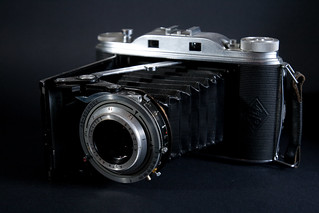Difference between revisions of "Agfa Record"
m (Minor explanation on RF for Record III) |
Hanskerensky (talk | contribs) (Added link to review) |
||
| (10 intermediate revisions by 3 users not shown) | |||
| Line 1: | Line 1: | ||
| − | |||
The '''Agfa Record''' is the name received by a series of [[folding camera|folding medium format cameras]] for 6x9 cm pictures on 120 film, made by the [[Agfa]] camera works in Münich (Germany). | The '''Agfa Record''' is the name received by a series of [[folding camera|folding medium format cameras]] for 6x9 cm pictures on 120 film, made by the [[Agfa]] camera works in Münich (Germany). | ||
| Line 8: | Line 7: | ||
Lens is always a multicoated, front-element focusing 105mm lens, with minimum focusing distance of about 1m/3ft. It can be one of Agfa's triplets (Agnar, Apotar) or Tessar-like formulation (Solinar), in all cases with maximum aperture of f/4.5 adjustable up to f/32. It has double exposure prevention mechanism. The external leatherette has Agfa's logo embossed on the front, and the model name is both embossed on the leatherette and engraved in a plate fitted to the lens bed. | Lens is always a multicoated, front-element focusing 105mm lens, with minimum focusing distance of about 1m/3ft. It can be one of Agfa's triplets (Agnar, Apotar) or Tessar-like formulation (Solinar), in all cases with maximum aperture of f/4.5 adjustable up to f/32. It has double exposure prevention mechanism. The external leatherette has Agfa's logo embossed on the front, and the model name is both embossed on the leatherette and engraved in a plate fitted to the lens bed. | ||
| − | |||
==Models== | ==Models== | ||
The Record series followed a naming convention similar to that used for the [[Isolette|Agfa Isolette]] series. | The Record series followed a naming convention similar to that used for the [[Isolette|Agfa Isolette]] series. | ||
| − | |||
===Agfa Record I=== | ===Agfa Record I=== | ||
| Line 27: | Line 24: | ||
The '''Agfa Record I''' is a direct viewfinder 6x9 folding camera. | The '''Agfa Record I''' is a direct viewfinder 6x9 folding camera. | ||
| − | It has the film advance wheel at the left side of the top cover, opposite to a sliding depth-of-field calculator. Typically, it has a 4-speed [[Pronto]] shutter with 25-200 speeds, but it was available as an option with [[Prontor|Prontor, Prontor-S or Prontor-SV]]. | + | It has the film advance wheel at the left side of the top cover, opposite to a sliding depth-of-field calculator. Typically, it has a 4-speed [[Pronto]] shutter with 25-200 speeds, but it was available as an option with [[Prontor|Prontor, Prontor-S or Prontor-SV]]. A lower-priced 3-speed Vario shutter was also available. The camera was equipped with either an Agnar 105mm f/6.3 or Agnar 105mm f/4.5 lens.<ref>Der Fotohelfer, Photo-Porst, c.1951, page 79 (German)</ref> |
| − | |||
{{br}} | {{br}} | ||
| Line 34: | Line 30: | ||
{{Flickr image | {{Flickr image | ||
| image_source=http://www.flickr.com/photos/paulclayton/2460102122/in/pool-camerawiki/ | | image_source=http://www.flickr.com/photos/paulclayton/2460102122/in/pool-camerawiki/ | ||
| − | | image=http://farm3.staticflickr.com/2393/ | + | | image=http://farm3.staticflickr.com/2393/2460102122_0861e77b87_n.jpg |
| image_align=right | | image_align=right | ||
| image_text= | | image_text= | ||
| Line 45: | Line 41: | ||
Instead of the DOF calculator available on the previous model, some Record II units (like the pictured at the right here) have a sliding button to lock the shutter release button (acting as kind of "T" mode). | Instead of the DOF calculator available on the previous model, some Record II units (like the pictured at the right here) have a sliding button to lock the shutter release button (acting as kind of "T" mode). | ||
| − | Typically, it has a 8-speed [[Prontor|Prontor, Prontor-S or Prontor-SV]] shutter with 1-250 speeds plus B mode. | + | Typically, it has a 8-speed [[Prontor|Prontor, Prontor-S or Prontor-SV]] shutter with 1-250 speeds plus B mode. The camera was available with an Apotar 105mm f/4.5 lens in either the Prontor S or SV shutter, and a Solinar 105mm f/4.5 lens in a Synchro-Compur S shutter.<ref>Der Fotohelfer, Photo-Porst, c.1951, page 87 (German)</ref> |
{{br}} | {{br}} | ||
| Line 61: | Line 57: | ||
The main difference of the '''Agfa Record III''' model is the inclusion of an uncoupled<ref>Uncoupled means that the distance is measured with the coincident rangefinder, then take the distance read and transfer it to the lens by rotating the front element.</ref> [[rangefinder (device)|rangefinder]], quite similar to that used on the [[Isolette|Agfa Isolette]]. The rangefinder is operated with a small knurled thumb-wheel on the right hand of the raised part of the top housing, and the distance is read off and transferred to the lens, which has front-element focusing like all the Record. | The main difference of the '''Agfa Record III''' model is the inclusion of an uncoupled<ref>Uncoupled means that the distance is measured with the coincident rangefinder, then take the distance read and transfer it to the lens by rotating the front element.</ref> [[rangefinder (device)|rangefinder]], quite similar to that used on the [[Isolette|Agfa Isolette]]. The rangefinder is operated with a small knurled thumb-wheel on the right hand of the raised part of the top housing, and the distance is read off and transferred to the lens, which has front-element focusing like all the Record. | ||
| − | Typically, it has a 8-speed [[Prontor|Prontor, Prontor-S or Prontor-SV]] shutter with 1-250 speeds plus B mode. | + | Typically, it has a 8-speed [[Prontor|Prontor, Prontor-S or Prontor-SV]] shutter with 1-250 speeds plus B mode, using an Apotar 105mm f/4.5 lens. The top model features a f/4.5 105mm Solinar lens and a Synchro-Compur shutter with 1/500 s top speed. |
{{br}} | {{br}} | ||
| − | == | + | ==References== |
<references /> | <references /> | ||
| Line 75: | Line 71: | ||
In English: | In English: | ||
| − | * [ | + | *[https://www.butkus.org/chinon/agfa/agfa_recorder_i-ii/agfa_recorder_i-ii-english.htm Agfa Record I and II user manual] at [https://www.butkus.org/chinon/ Butkus.org] |
| + | * [https://certo6.com/camera-archive/agfa-record/ Record series] and [https://certo6.com/wp-content/uploads/2018/05/recordIII-manual.pdf Record III manual] from [http://www.certo6.com/ Certo6.com] | ||
| + | *[https://photojottings.com/agfa-record-iii-105mm-f-4-5-solinar-review/ Agfa Record III review] at [https://photojottings.com/ Photo Jottings] | ||
In French: | In French: | ||
| Line 84: | Line 82: | ||
| − | [[Category: A]] [[Category: | + | [[Category: A]] |
| + | [[Category:Agfa|Record]] | ||
| + | [[Category:R|Record Agfa]] | ||
| + | [[Category:German 6x9 viewfinder folding]] | ||
| + | [[Category:German 6x9 rangefinder folding]] | ||
| + | [[Category:120 film]] | ||
Latest revision as of 04:22, 3 September 2023
The Agfa Record is the name received by a series of folding medium format cameras for 6x9 cm pictures on 120 film, made by the Agfa camera works in Münich (Germany).
Contents
Description
The Agfa Record is a vertical, self-erecting 6x9 medium format folder. Its dimensions are 162 mm x 98 mm x 43 mm (closed), 162 mm x 98 mm x 125 mm (open, W x H x D).
The Agfa Record had a chromed top housing and, on top of it, centered, there is an accessory flash shoe attached with one single screw. The wheel advance is always located at photographer's left hand, and there is one button next to it for opening the front door. The shutter release button is located at the right side of the cover, and the button can accomodate a remote cable.
Lens is always a multicoated, front-element focusing 105mm lens, with minimum focusing distance of about 1m/3ft. It can be one of Agfa's triplets (Agnar, Apotar) or Tessar-like formulation (Solinar), in all cases with maximum aperture of f/4.5 adjustable up to f/32. It has double exposure prevention mechanism. The external leatherette has Agfa's logo embossed on the front, and the model name is both embossed on the leatherette and engraved in a plate fitted to the lens bed.
Models
The Record series followed a naming convention similar to that used for the Agfa Isolette series.
Agfa Record I

|
| Agfa Record 1 image by Raúl Sá Dantas (Image rights) |
The Agfa Record I is a direct viewfinder 6x9 folding camera.
It has the film advance wheel at the left side of the top cover, opposite to a sliding depth-of-field calculator. Typically, it has a 4-speed Pronto shutter with 25-200 speeds, but it was available as an option with Prontor, Prontor-S or Prontor-SV. A lower-priced 3-speed Vario shutter was also available. The camera was equipped with either an Agnar 105mm f/6.3 or Agnar 105mm f/4.5 lens.[1]
Agfa Record II

|
| image by Paul Clayton (Image rights) |
The Agfa Record II is a direct viewfinder 6x9 folding camera.
Instead of the DOF calculator available on the previous model, some Record II units (like the pictured at the right here) have a sliding button to lock the shutter release button (acting as kind of "T" mode).
Typically, it has a 8-speed Prontor, Prontor-S or Prontor-SV shutter with 1-250 speeds plus B mode. The camera was available with an Apotar 105mm f/4.5 lens in either the Prontor S or SV shutter, and a Solinar 105mm f/4.5 lens in a Synchro-Compur S shutter.[2]
Agfa Record III

|
| Agfa Record III image by Alfredo Cofré (Image rights) |
The main difference of the Agfa Record III model is the inclusion of an uncoupled[3] rangefinder, quite similar to that used on the Agfa Isolette. The rangefinder is operated with a small knurled thumb-wheel on the right hand of the raised part of the top housing, and the distance is read off and transferred to the lens, which has front-element focusing like all the Record.
Typically, it has a 8-speed Prontor, Prontor-S or Prontor-SV shutter with 1-250 speeds plus B mode, using an Apotar 105mm f/4.5 lens. The top model features a f/4.5 105mm Solinar lens and a Synchro-Compur shutter with 1/500 s top speed.
References
Links
In English:
- Agfa Record I and II user manual at Butkus.org
- Record series and Record III manual from Certo6.com
- Agfa Record III review at Photo Jottings
In French:
- Agfa Record II, Agfa Record III on www.collection-appareils.fr by Sylvain Halgand
In Spanish:
- Agfa Record Series at Historia de Bolsillo by J. Noir